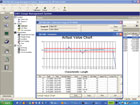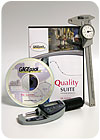
Source: Fernando Mengoni
Regardless of size, facilities with the need to calibrate instruments can benefit from the implementation of calibration software. Such software allows an organization to keep all calibration records, calibration procedures and requirements, instrument location and instrument history records in a secure, readily accessible database.
Automation of calibration management is another key advantage; for example, calibration software may have the ability to alert the operator when an instrument is due, prevent the use of overdue instruments and communicate the overall performance of the measurement system.
Mary McAtee, vice president of implementation services for IBS America (Lexington, MA), states that automated management trumps the abilities of homegrown software “because an Access database or an Excel spreadsheet still counts on someone going and looking at it periodically and acting on what the software is telling them vs. selecting software that is going to reach out and say, ‘This material is due.’” The software will give either a report to run or actually send an e-mail to remind the operator that the gage is due for calibration, they failed to take action or the gage is missing. With IBS’ software, instrument due-date alerts escalate through an organization’s hierarchy. For example, if an operator is not responding to the alerts he is receiving on the shop floor that a gage is almost due or due, the shop manager also will receive e-mail notification that the issue is not being dealt with.
Because of the above attributes, calibration software is key to the success of many process improvement initiatives and satisfying industry or customer requirements. McAtee says, “Virtually any compliance regulation considers control of gages and gage certainty measurement a bedrock. If you aren’t starting from a good, reliable basis to do a measurement, then every other decision you make about material or process is going to be flawed.” When compared to traditional calibration record keeping, such as homegrown software or a paper system, a good calibration solution will ensure that correctly calibrated instruments are being used and that high-quality records and reports are being generated.
When an organization is being audited, calibration software can facilitate both preparation and the audit itself. As Gordon Constable, Ph.D., PQ Systems (Miamisburg, OH) consultant, and Matthew Savage, PQ Systems technical support manager, state, “Understanding a paper system and locating records within it can be daunting tasks. With computerized approaches, verifying that the system works correctly is the task of interest, rather than simply focusing on how the system works.”
Today’s calibration solutions will typically be able to integrate with measurement system assessment (MSA) activities and inspection software. Other key features include bar code reading, expansive statistical capabilities, automated printing of labels and certificates, grouping of instruments and visual representations of instruments.
In general, calibration solutions are moving toward such practices as the use of centralized databases to allow multiple users and locations to share data, and software as a service (SaaS) Web-based solutions. And because many organizations outsource a large amount of their calibration needs, solutions are available that allow users to interface with their calibration vendors.

With IBS’ software, instrument due-date alerts escalate through an organization’s hierarchy, ensuring that instruments are calibrated according to schedule. Source: IBS America
Considerations
When considering which calibration software solution fits an organization’s needs, a user requirement specification should be developed. An organization should thoroughly analyze prospective solutions, asking questions such as:• Will the software help fulfill industry or customer requirements?
• Does the organization require expansive or basic functionality and features in a solution?
• How many users or locations will need access to the software?
Organizations also should be aware of factors such as whether or not a solution supports a calibration system directly, integrates with other enterprise systems, offers bar code reading, or has the capability to expand to perform future tasks. Besides initial cost incurred at purchase, find out how often software is updated, what type of support is offered and what additional costs are incurred, such as maintenance activities.
While such basic considerations seem common sense, many organizations fail to thoroughly evaluate a solution and, therefore, buy a product that is not a good fit. Nick Volpone, president, Prime Technologies Inc. (West Chester, PA), has encountered cases time and again in which organizations have bought software without extensive evaluation, ultimately finding that it proved to be useless. “Different industries attach varying levels of importance to specific features and functions. No one program is perfect for every use,” he says.
McAtee points out that organizations having corrective action systems or nonconformance reporting systems often buy calibration software that does not integrate with its other systems, such as the inventory management system, enterprise resource planning (ERP) system or the bill of materials system. The lack of integration can cause problems. For example, McAtee says, “If I find a bad gage, and I think there is a chance that defective material was produced with it, how difficult is it going to be for the company to generate a nonconforming material report?”
Organizations also should bear in mind that software can usually be modified by the developer to suit a customer’s needs. While this ensures that the customer gets exactly what they want, PQ Systems’ Constable and Savage caution the practice of user modification. “Some users think they can modify the software themselves by changing the database structure. This more often than not creates problems-especially when converting to new versions.”
And while the developer may be able to provide a host of customized features, Prime’s Volpone points out that an organization should review the credentials of a prospective software vendor. “A universal factor to consider is the internal quality controls of the developer. Documented evidence of the internal controls incorporating design specification approvals, version control and final acceptance testing are strong indicators that the software will perform as expected.” When features alone are the deciding factor of a purchase, a functionally flawed solution may be the result.

InfinityQS’s calibration software communicates with proprietary SPC software, making it impossible to collect data with a gage that has failed calibration. Source: InfinityQS International
Price vs. Capability
Calibration software ranges in price and capability, and an organization’s situation, size, throughput and resources should dictate product selection. Low-cost solutions are appropriate for small shops in which calibration data is needed for only one location, few instruments need calibrating and minimum requirements for industry compliance need to be met. These will be stand-alone solutions that offer basic gage surveillance features, calibration and measurement history, and reporting tools. Low-cost programs have the ability to facilitate compliance to current industry standards, but Devin Brent Ellis, client solutions director, Cybermetrics Corp. (Scottsdale, AZ), cautions, “They usually don’t have the resources to keep up with new technologies or changing standards.”Mid- to high-end software is appropriate for organizations looking to implement a large deployment of a common solution. Such software will be feature rich and will have advanced statistical capabilities; furthermore, it will enable multiple users and locations to share data through the use of centralized databases or Web-based architecture.
Rick Sloop, senior application engineer for InfinityQS International (Chantilly, VA), states, “When multiple computers or manufacturing locations require access to calibration data, a system that allows open database connectivity (ODBC) to a central database is required. In laboratory environments, a hosted Web-based solution that automatically collects calibration data from instruments may be the answer.” Also, mid- to high-range software will provide scalability, reliable product support and a focus on continuous adherence to industry standards such as ISO 9001 and ISO/IEC 17025, with solutions that satisfy the requirements of 21 CFR Part 11 and 10 CFR 50 tending to be more expensive.

GAGEpack can be modified to fit each customer’s needs. The system can include R&R activities, maintenance activities and more than a hundred terms describing gages. Source PQ Systems Inc.
A Web-Based Tomorrow
Centralized databases and Web-based solutions are the future of calibration software. As an example, these solutions can allow organizations to share data across continents, or allow them to be better informed of what their calibration vendors are doing domestically.Calibration software is expected to continue to evolve into even more of a one-stop gage management solution. Also, it is expected that advances in stability checks and better integration with bar coding will soon find their way into standard software packages. “Everything comes back to process, to being able to look at the performance of the gage overtime,” says McAtee. “That is where calibration is moving-to actually being able to give trend information and let people know if the gage is really adequate for the process they are using it for.”Q
For more information on the companies mentioned in this article, visit their Web sites:
- Cybermetrics Corp., www.cybermetrics.com
IBS America, www.ibs-us.com
InfinityQS International, www.infinityqs.com
PQ Systems Inc., www.pqsystems.com
Prime Technologies Inc., www.primetechpa.com
Quality Online
Visit www.qualitymag.com and type “Calibration Software” into the search engine to find related articles. Among the results you’ll find:- “How to Choose a Calibration Software Solution”
- “Size Up Gage Calibration Software”
- “Successful Software Selection”